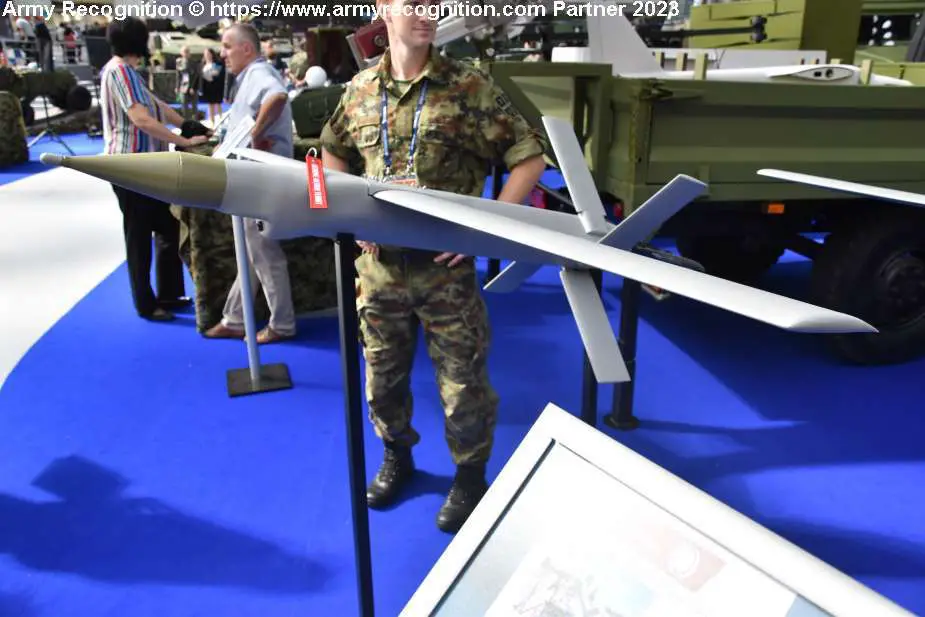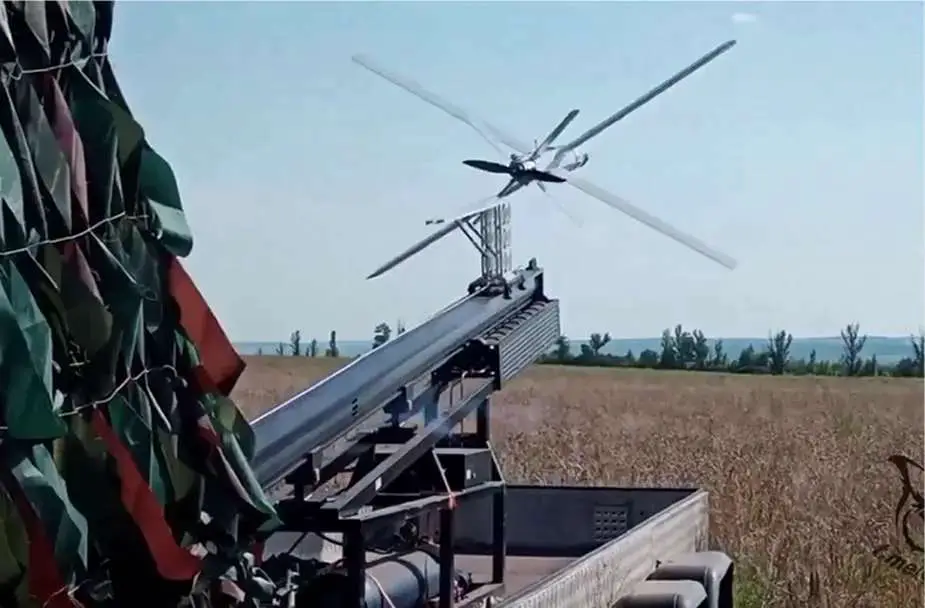As demonstrated by the Partner 2023 exhibition in Serbia, the landscape of modern warfare is currently undergoing a significant shift, driven by the increasing utilization of loitering munitions (kamikaze drones). These unmanned aerial systems, such as the new Serbian OSICA, purpose-built for locating and neutralizing enemy targets, are rapidly gaining importance in the military market.
Follow Army Recognition on Google News at this link

The OSICA loitering munition showcased at the Partner 2023 exhibition in Serbia (Picture source: Army Recognition)
During the exhibition, the Military Technical Institute (VTI), the largest military scientific and research institution in Serbia, introduced the OSICA Loitering Munition System. The OSICA, an acronym for "One-time Shaped-charge Intelligence Combat Aerial System," is a fully autonomous loitering unmanned aerial system primarily designed for attack missions, which puts it in the kamikaze drone category.
What sets kamikaze drones such as the OSICA apart is their cost-effectiveness combined with a high-precision strike capability, especially against armored vehicles. In the case of the Serbian drone, this capability is achieved through the incorporation of a shaped-charge warhead derived from the anti-tank weapon system M79 Osa. This loitering munition is equipped with a fixed ultra-compact full-HD camera module and a video processor, enabling it to autonomously detect and engage targets with exceptional accuracy, thanks to its advanced video tracking system.
The OSICA includes a suite of advanced technologies, including a flight control computer developed by the Military Technical Institute, whose functionality has been rigorously tested and validated on the Unmanned Aerial System (UAS) Vrabac. Furthermore, the OSICA offers the flexibility of executing missions either in cooperation with other systems or via the UAS Vrabac.
This Serbian loitering munition includes a maximum takeoff weight (MTOW) of 7 kg, an operative speed of 120 km/h, an operative altitude of 500 m, an endurance exceeding 30 mn, a communication link range of 20 km, and an electric engine. Its warhead weighs 1.5 kg, with a penetration capability of 500 mm against armored targets. To facilitate its rapid deployment, the system employs a fully automated lightweight pneumatic catapult launcher, a method reminiscent of the Russian ZALA Lancet launching system used in Ukraine.

The Serbian OSICA loitering munition uses a catapult launcher system, a method reminiscent of the Russian ZALA Lancet in Ukraine (Picture source: Russian social media)
The increasing appearance of new loitering munitions such as the OSICA represents an evolution in military technology, offering cost-efficient, precise, and versatile capabilities that could prove valuable in modern battlefield scenarios.
Loitering munitions, also known as kamikaze drones, are hybrids that combine aspects of traditional drones and guided missiles. Unlike conventional drones primarily used for reconnaissance or payload delivery, kamikaze drones are equipped with explosive warheads and are programmed to loiter over designated target areas. Once an enemy target is identified, these drones initiate a dive, detonating their warheads upon impact.
The Ukrainian conflict has served as a significant testing ground for kamikaze drones. Both Ukrainian and Russian forces have employed these drones due to their cost-effectiveness. They can target individual foot soldiers and pose a threat to armored vehicles, including the T-90M and Leopard 2A6 tanks.
Kamikaze drones have demonstrated their effectiveness, particularly in anti-tank operations. This capability levels the playing field against more heavily armored adversaries. Their precision and loitering capabilities also make them suitable for urban warfare scenarios, where traditional artillery may cause unacceptable collateral damage. Additionally, kamikaze drones can autonomously detect and locate enemy artillery, enhancing their utility in counter-battery operations.
Technological advancements in kamikaze drones are advancing rapidly. Notable innovations include the Rotem Alpha by Israeli defense firm IAI, which can be deployed within minutes from a backpack. It features a shaped charge warhead capable of penetrating up to 600 millimeters of armor plate and advanced sensors, including an acoustic sensor suite for enemy vehicle detection.
Russian FPV kamikaze drones have also seen significant progress, despite initial resistance from military authorities. These drones are now equipped with larger warheads and smarter guidance systems and are mainly used by irregular units and contractors.
Several factors contribute to the rapid rise of kamikaze drones and loitering munitions. Their cost-effectiveness is a significant driver, as these drones offer a relatively inexpensive option with a potentially high return on investment. The pace of technological innovation has resulted in drones with longer flight times, improved sensors, and more potent warheads. Kamikaze drones offer a new level of tactical flexibility, capable of various roles, from anti-tank operations to counter-artillery missions. Moreover, advanced models allow operators to control drones from secure locations, such as bunkers or armored vehicles, significantly reducing the risk to human operators.















